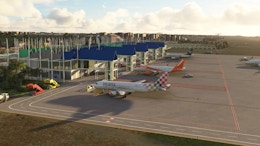When I switched to Microsoft Flight Simulator as my primary sim over Prepar3D a little over a year ago, I was a little lost. In P3D, I used to fly my PMDG Boeings all over the world all day long. In MSFS this was not yet possible at the time, and it left me searching for a new plane to like. Until MSFS, I had barely touched GA aircraft, but as a bit of a history buff, FlyingIron Simulations’ Spitfire drew my attention. After a few flights, I had discovered my new passion: warbirds. Since then I’ve added numerous warbirds to my hangar, including the previously mentioned Spitfire by FlyingIron Simulations as well as their P-38 Lighting. It’s hard for me to tell you what it is I like about warbirds, but what I can tell you is that whether you like planes for their looks, powerful engines, sounds or capabilities, the F6F Hellcat by FlyingIron Simulations has something here for everyone.
FlyingIron Simulations’ rendition of the F6F Hellcat promises to be an authentic one, featuring high quality modelling, textures, a high quality Wwise 3D sound set and a lot of custom modelling of the systems to make the aircraft behave authentically and accurately. In this review, we will go into all that, but before we dive into the aircraft, a little bit of history about this plane; the ace maker, the Zero killer.
The F6F Hellcat was introduced with the US Navy in 1943 to replace the F4F Wildcat. It quickly became the dominant fighter aircraft in the second half of the Pacific War, as it was able to counter the Japanese Mitsubishi A6M Zero. Another reason it gained such popularity was its prevalence over the F4U Corsair. Though the latter one was a faster aircraft, the plane had issues with visibility and carrier landings, and as such, was mostly in use with the US Marines as a land based aircraft. The F6F had no issues operating from aircraft carriers. The version modelled by FlyingIron Simulations is the F6F-5. The -5 featured several improvements over previous versions, including that of a water-injection system for the engine. It also featured a more streamlined engine cowling, improvements to the windscreen and a strengthened body. The F6F-5 was the most produced variant of the aircraft.
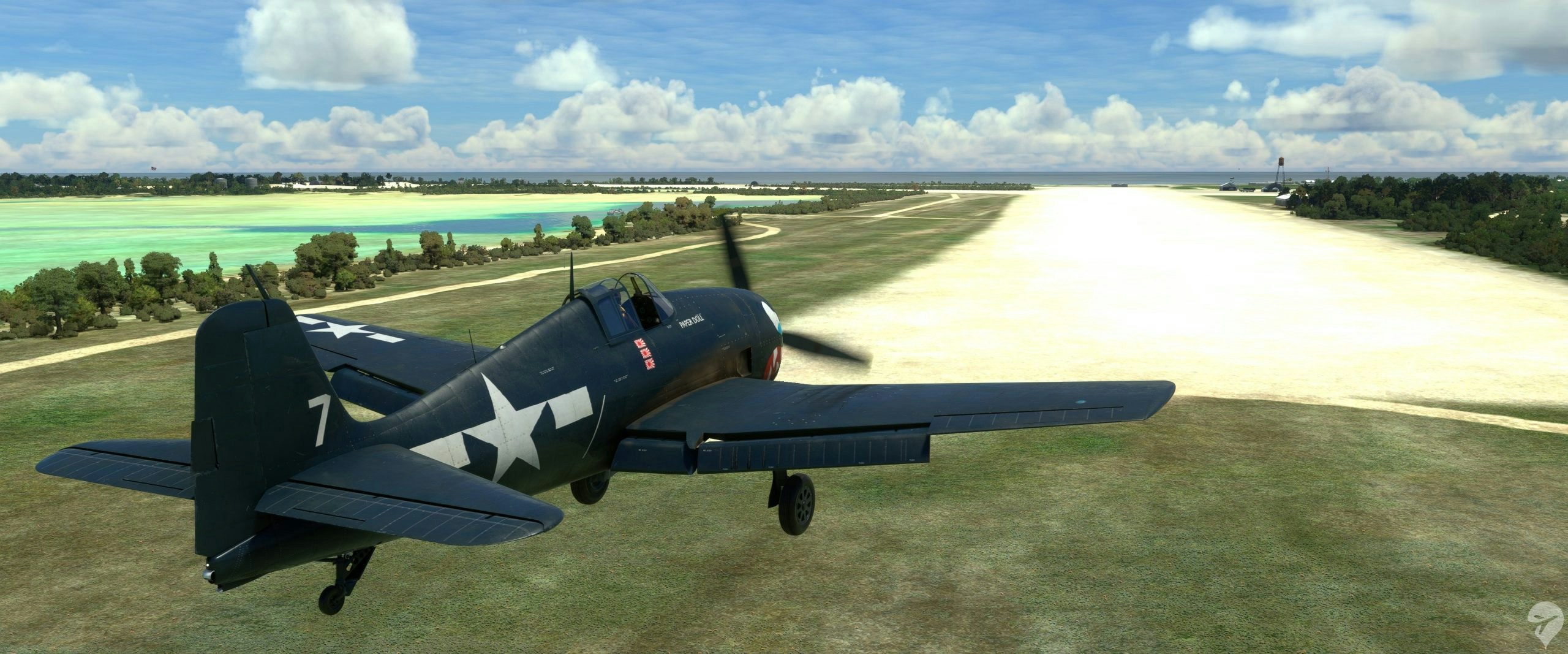

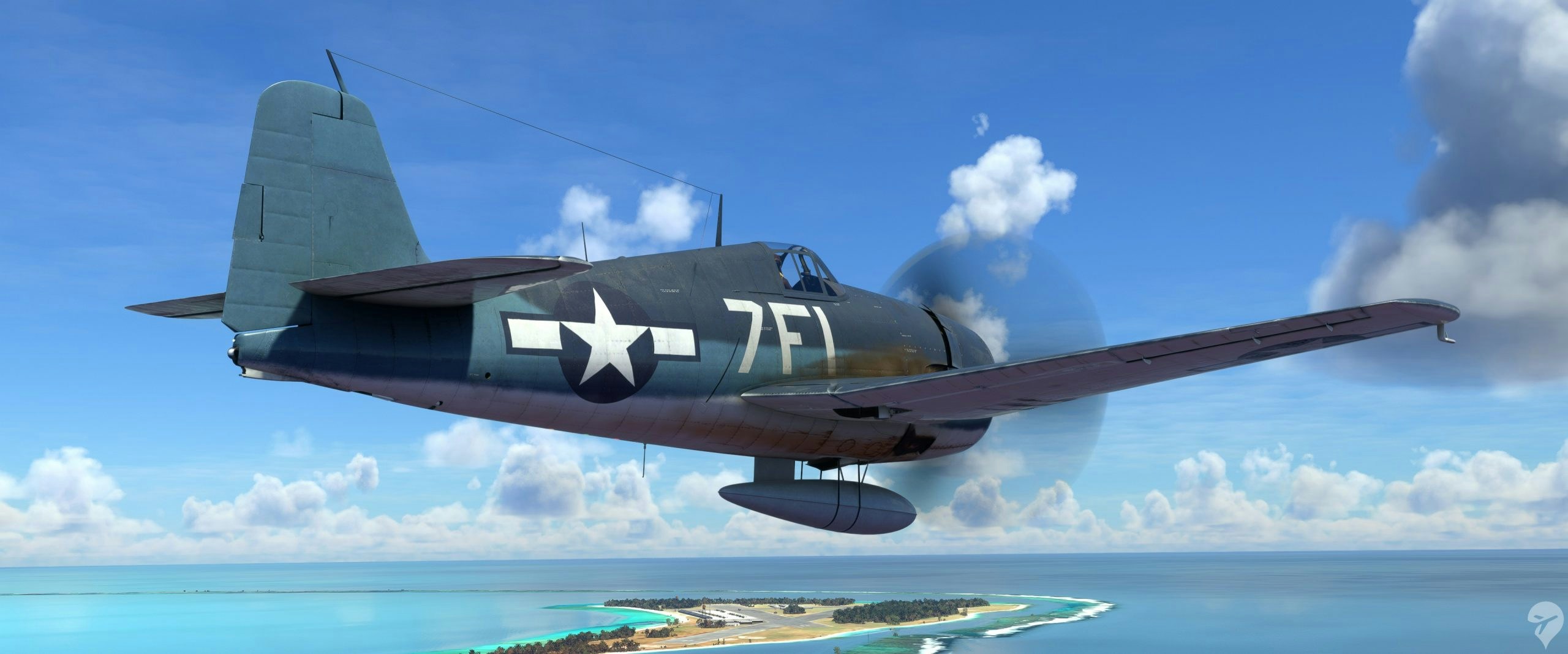

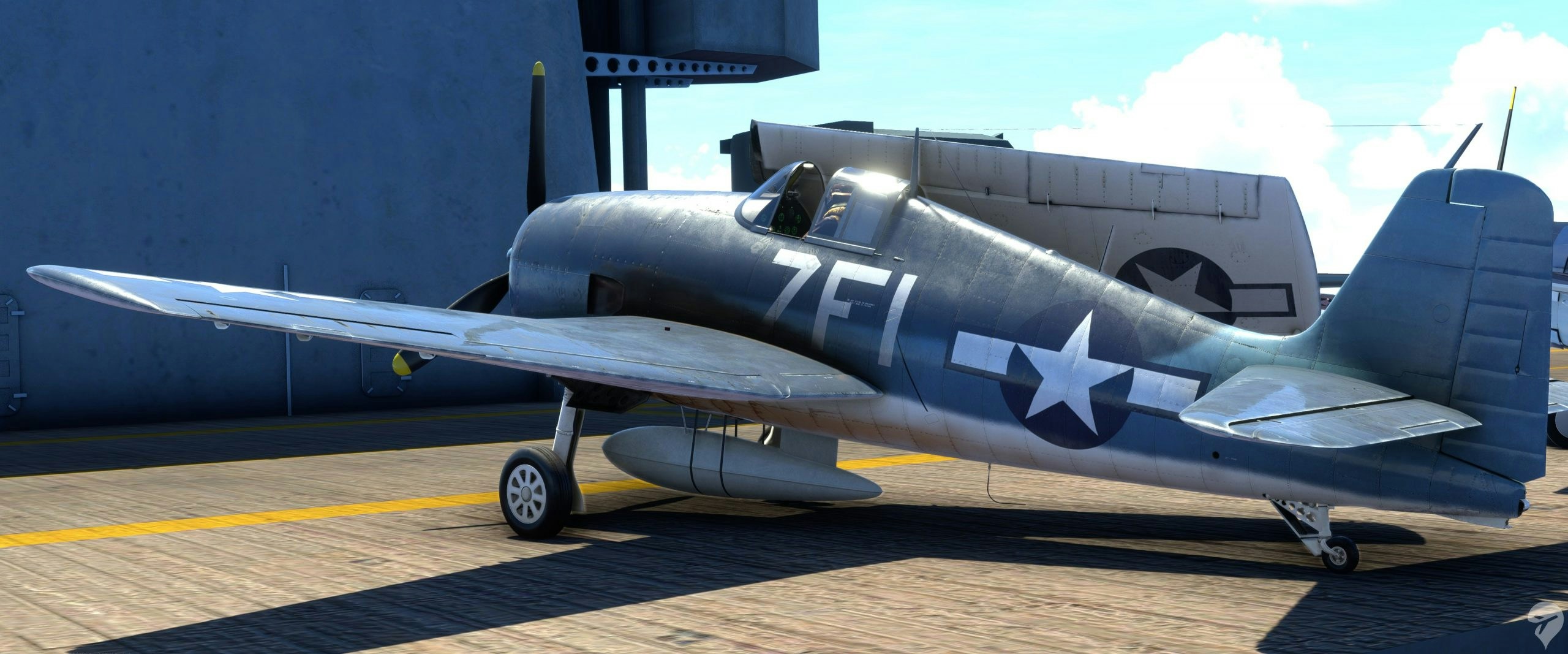
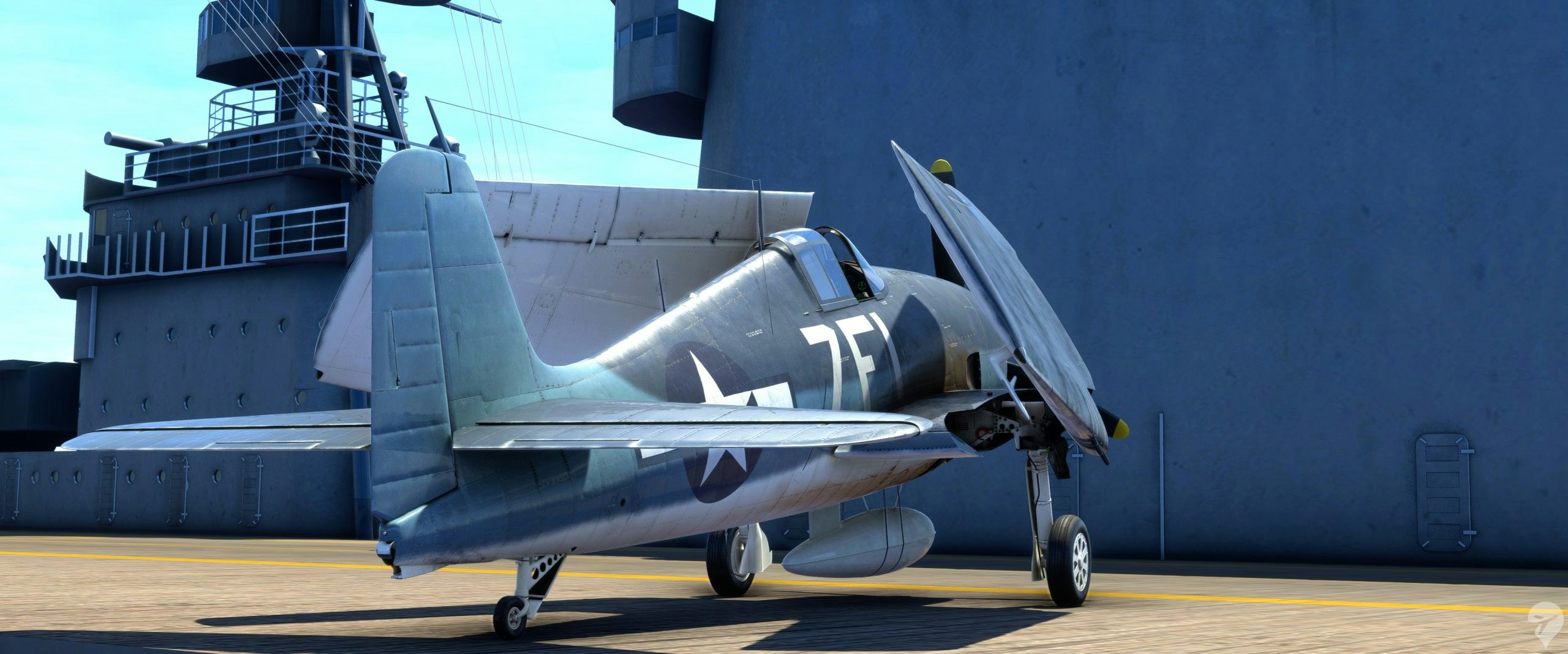
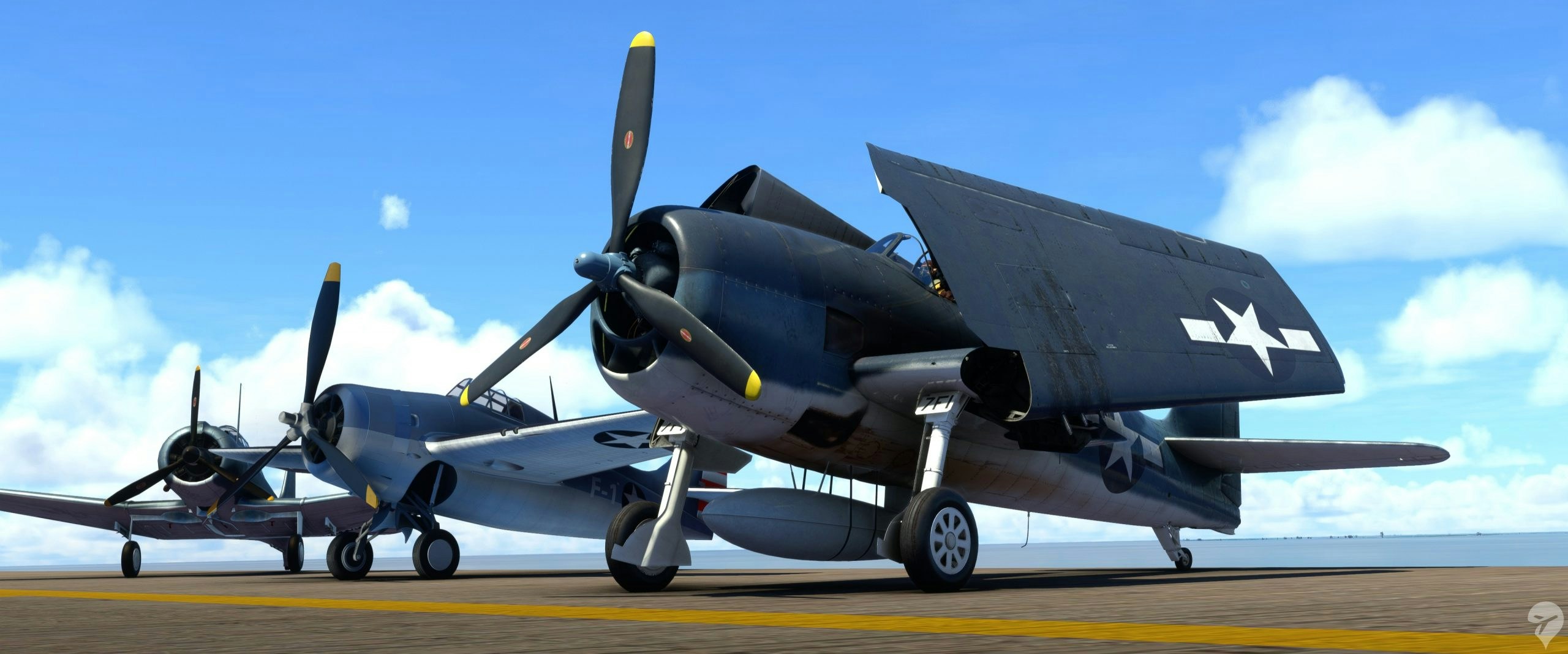
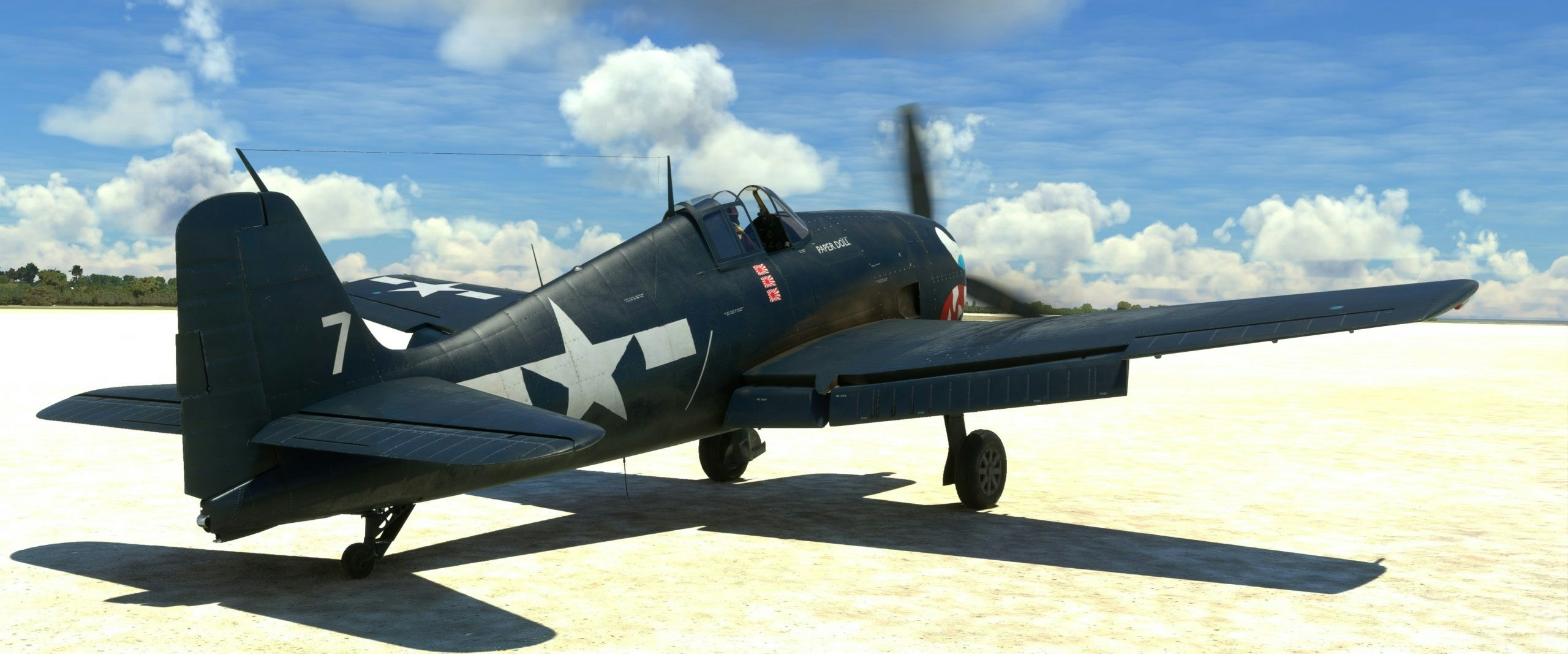
The F6F Hellcat is easily obtainable through FlyingIron Simulations’ own website. After payment you get a download link for a zip file which, once extracted, you simply need to move over to your Community folder. The plane is not yet available on the MSFS Marketplace, but will be in a few weeks time according to the developer. The Marketplace variant of the plane will lack any visible guns due to limitations by Microsoft. The manual, which is located inside the installation folder, comes in very handy for this plane. Not only does it contain your basic cockpit familiarisation, it also contains instructions on how to manage the engine as well as reference tables for power settings, fuel consumption, and speed. The aircraft also contains in-sim checklists. Reading the manual is quite imperative, as it’ll give you a lot of information about the most important part: how to manage and balance your engine performance and temperatures, including the supercharger, during your flight.
Once you’ve loaded up the Hellcat in the simulator, you will immediately notice the high quality of the cockpit modelling and textures. Everything has been modelled incredibly well with a lot of attention to detail. The modelling quality is very high and I have not noticed any jagged edges, low polygon shapes or unrefined shapes. The development team has spent a great amount of time on making this cockpit look good. The same goes for the textures inside the cockpit. They are of very high quality and contain a lot of attention to detail (minus a slight texture duplication on the aileron trim). There are elements of wear and tear on some elements, such as the aircraft floor or the fuel drop tank release. Having said that, I do feel the amount of wear and tear in this plane is a little light, and it seems almost absent from the most used controls. There is also no visible wear on where the pilot would get into the cockpit. Almost all the switches and controls are animated and have sound attached, although not all of them work. The switches related to the weapons (guns and bombs), the hydraulic hand-pump and the supercharger lever are merely aesthetic, as are a few other switches and the radio control box located on your starboard side in the cockpit. Most of the other switches are fully functional, including the circuit breakers and the canopy handle.
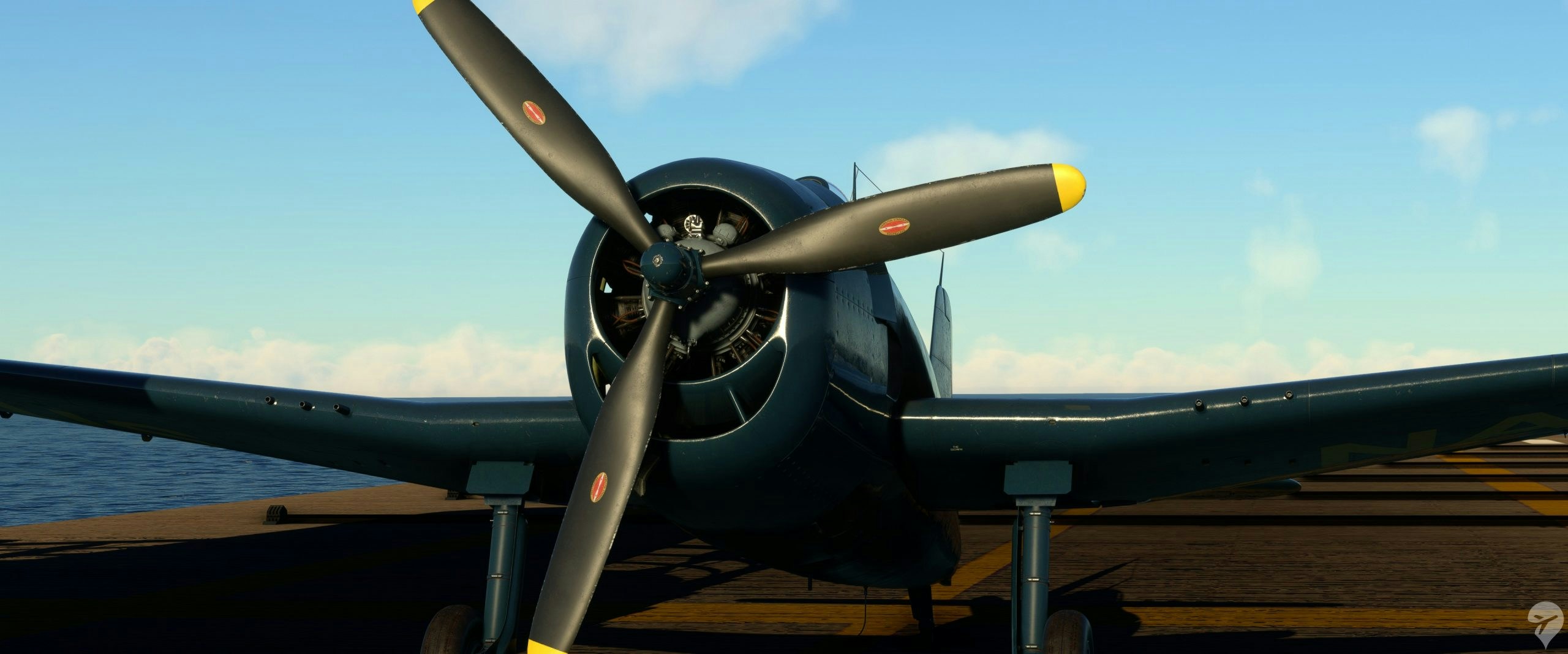
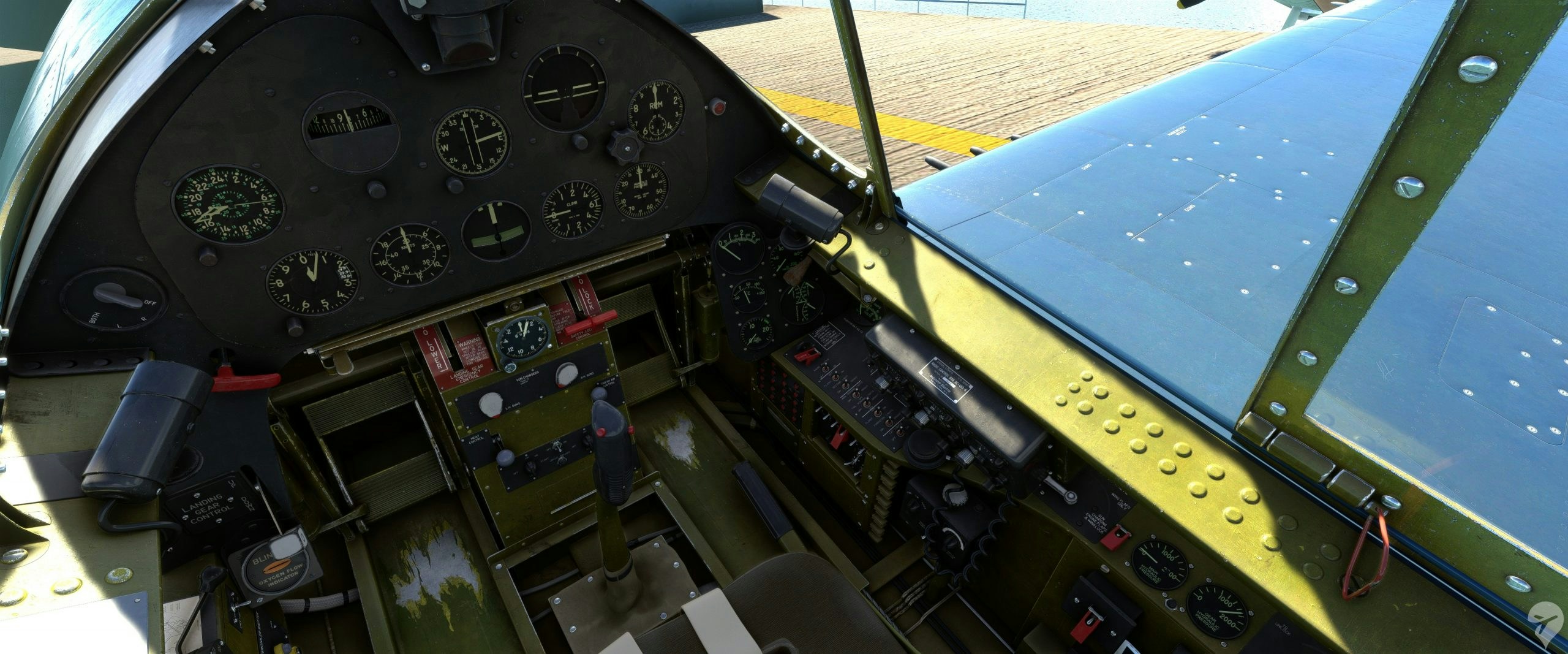
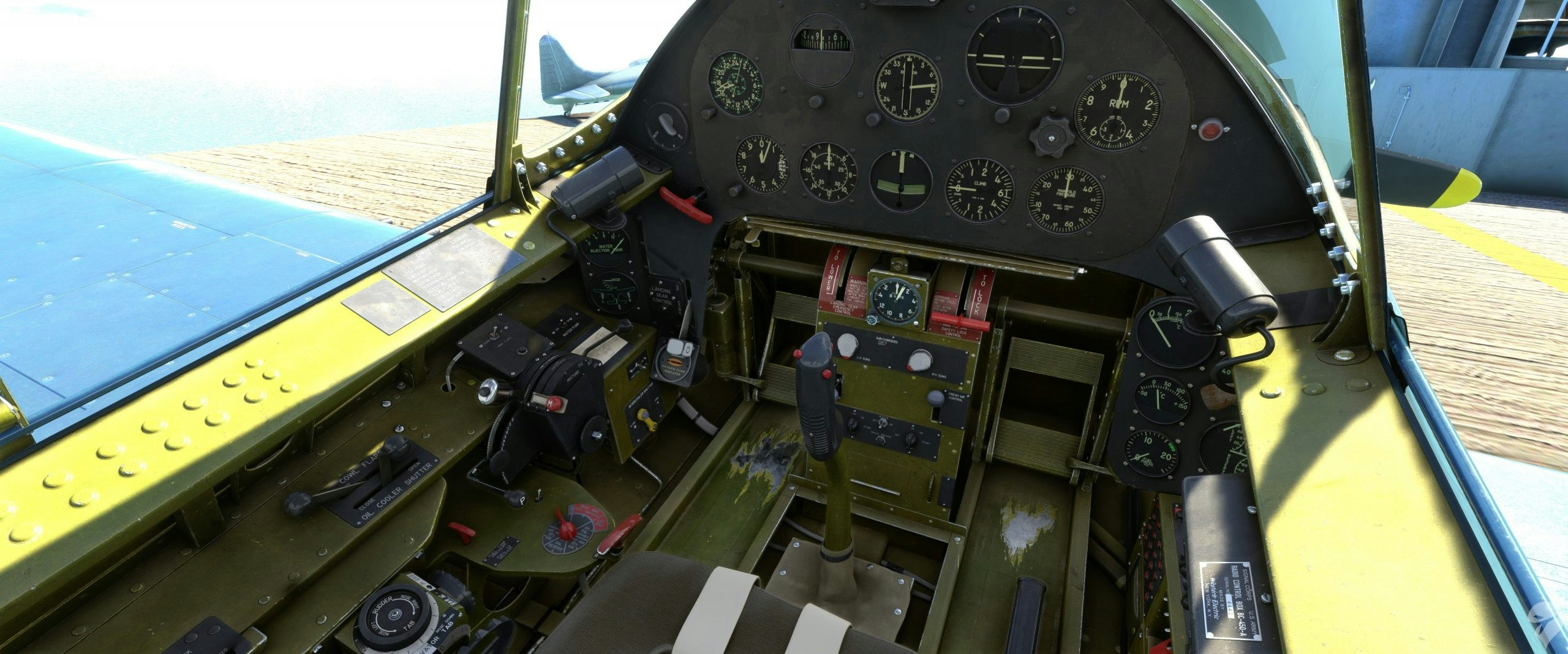
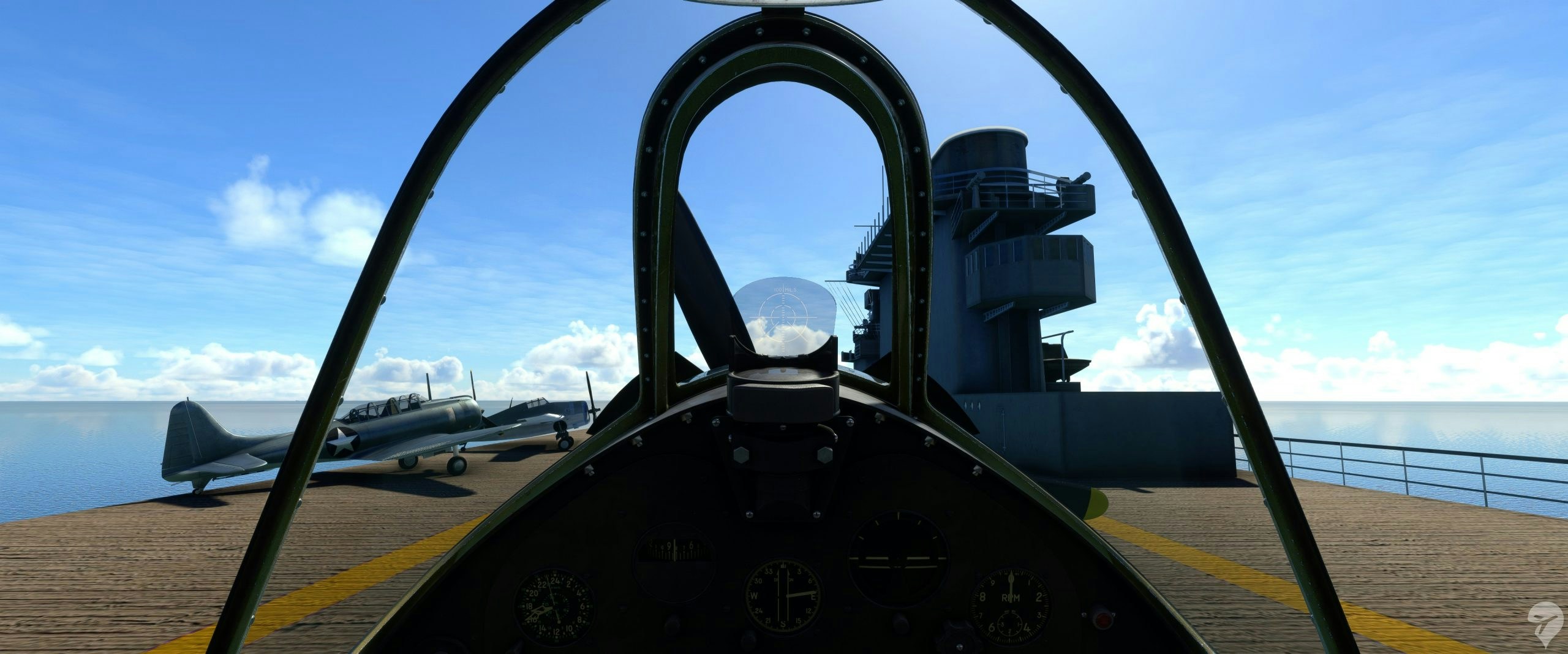
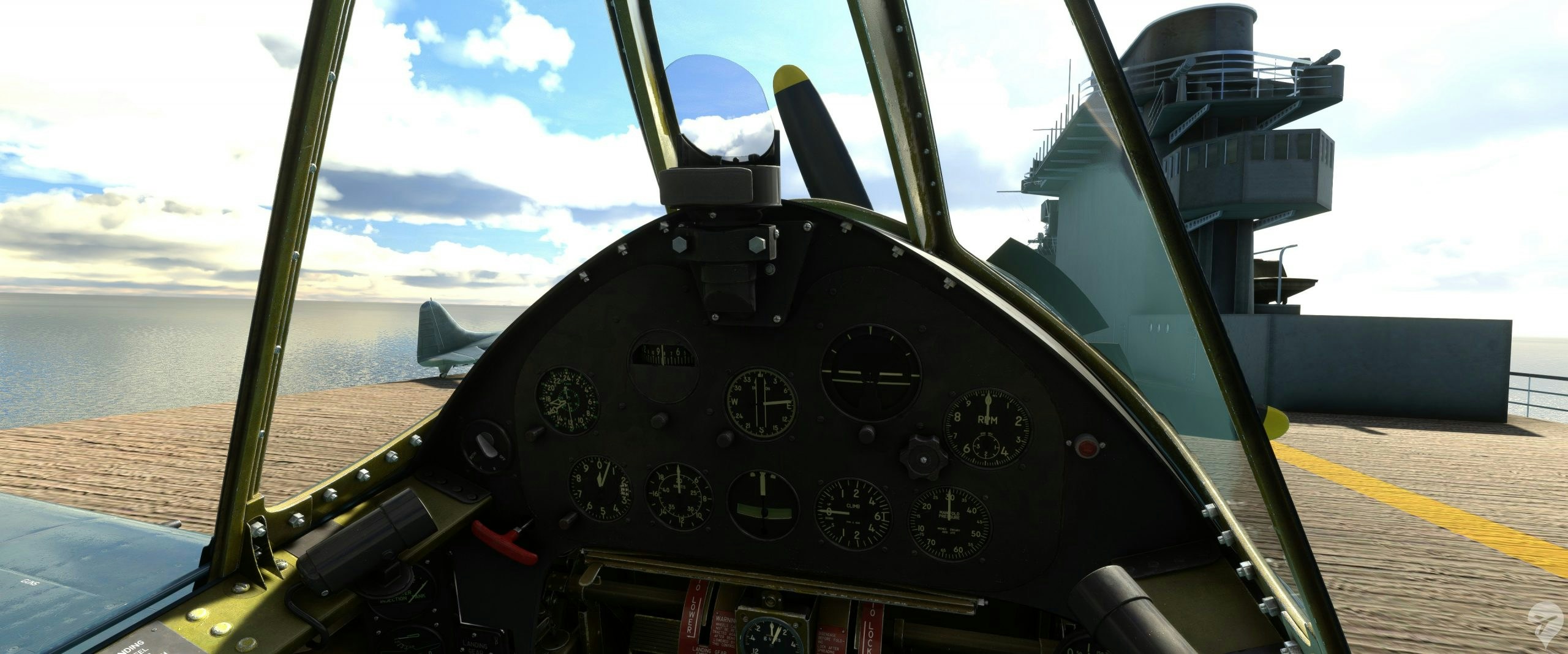
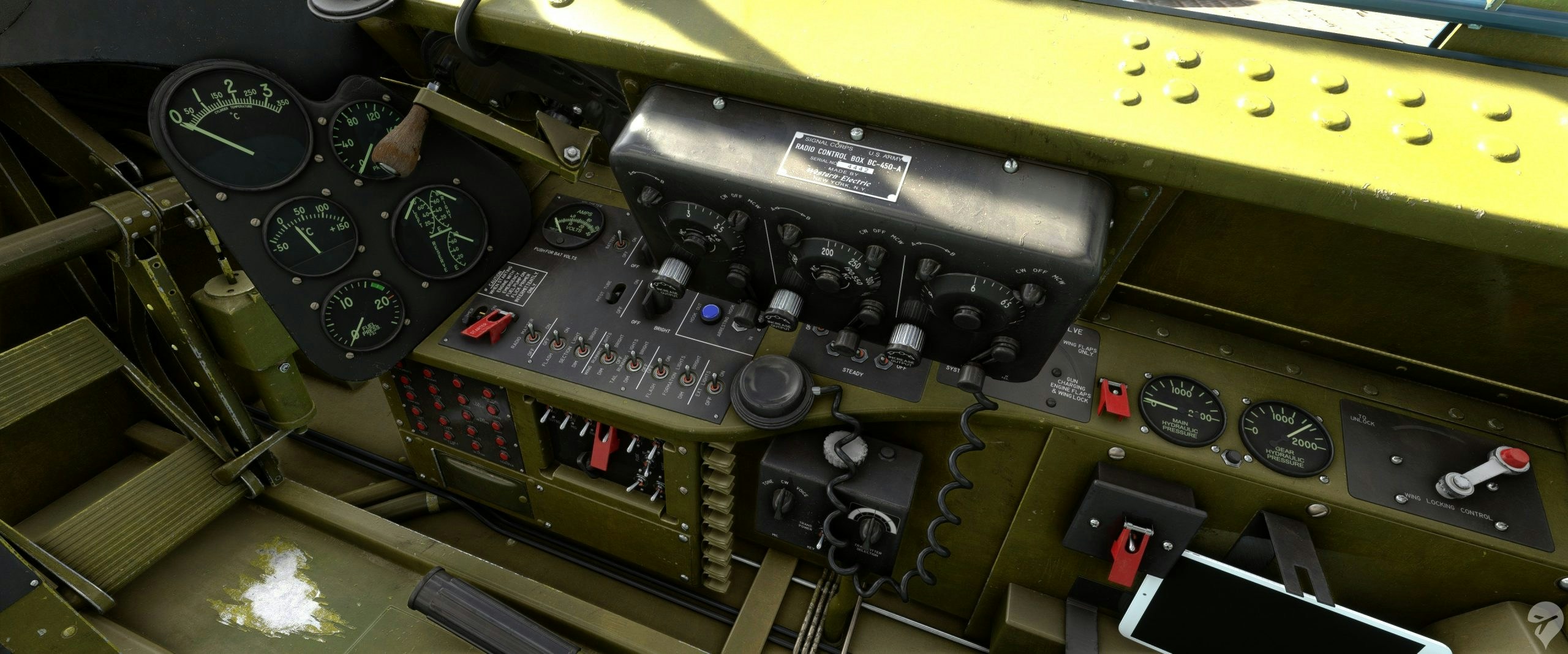

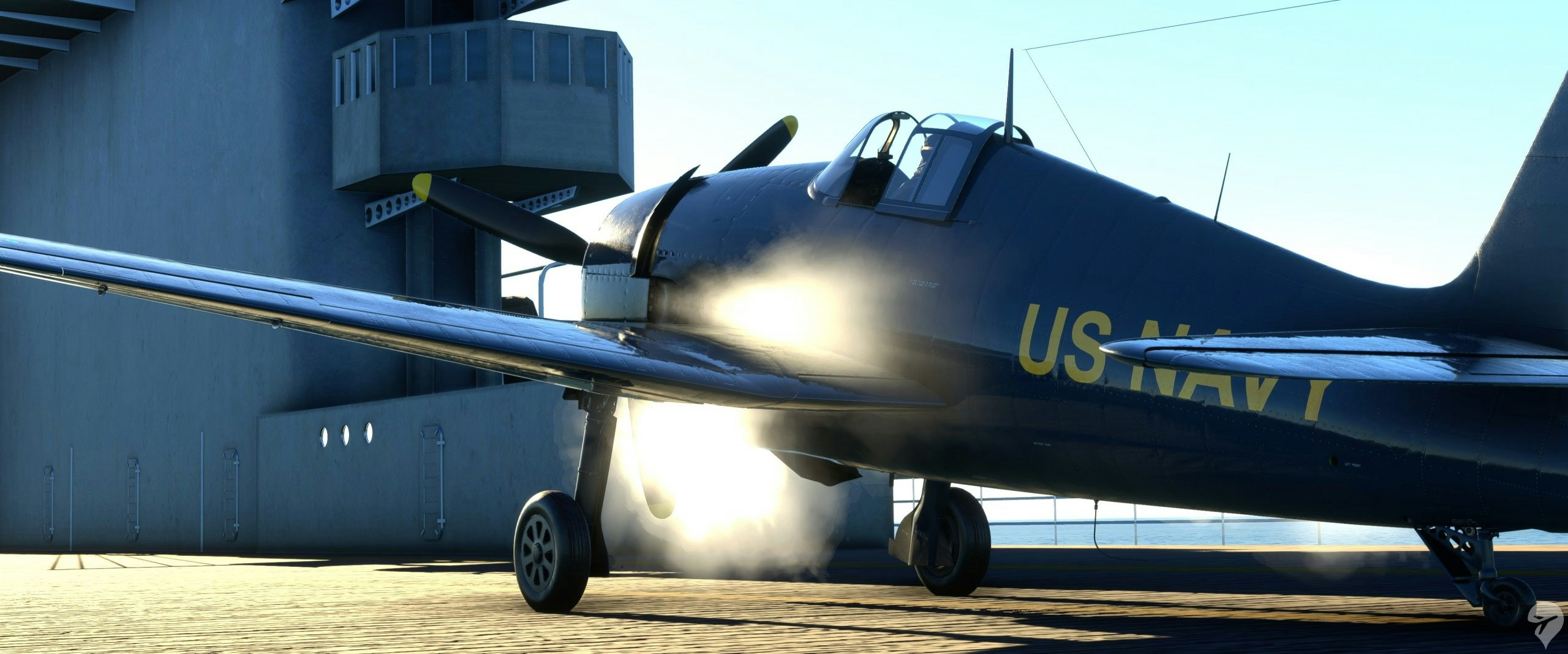
When we move our attention to the modelling and texture of the outside of the plane, we are met with an extension of what we already saw inside the cockpit. The exterior model of the plane has been crafted with a high amount of detail and finesse. Although the exterior does not have too many elements to it, we can see things like the antenna mast with cables running from and to it. The gear struts have been modelled in high detail, showing cables and other details. And the Wasp engine also looks great, with a large amount of detail to it. The exterior textures are also a joy to look at. There are several liveries included with the plane, all based on accurate paint schemes. The colours look very good, but more impressive are the details. You can see handprints on your plane from where mechanics must have put their hands to inspect and maintain the plane after your sorties. You’ll find dirty smudges from oil and grease and air around the exhausts, and dirty trailings around the gun ports. Once we fold the wings (yes, this plane has an animation for folding wings), we can see some more detail inside the wings – all adding to the refinement and immersion. Additionally the gear animation, which retracts in a rotating manner backwards into the wings, also looks really good.
After going through the start-up sequence, which is not hugely difficult, you are greeted with the mighty roar of the F6F Hellcat’s Pratt & Whitney R-2800-10W Double Wasp Radial engine. FlyingIron Simulations have hit the ball out of the park when it comes to the engine sound, and the sound design in general. The engine sounds are incredibly beautiful, and me writing about them does not do enough justice to this aspect of the plane. The sounds, both inside the cockpit as well as outside, are incredibly good. They are of a high quality and from what I can tell they sound very accurate. You can very clearly distinguish differences in RPM and power settings in the sounds.
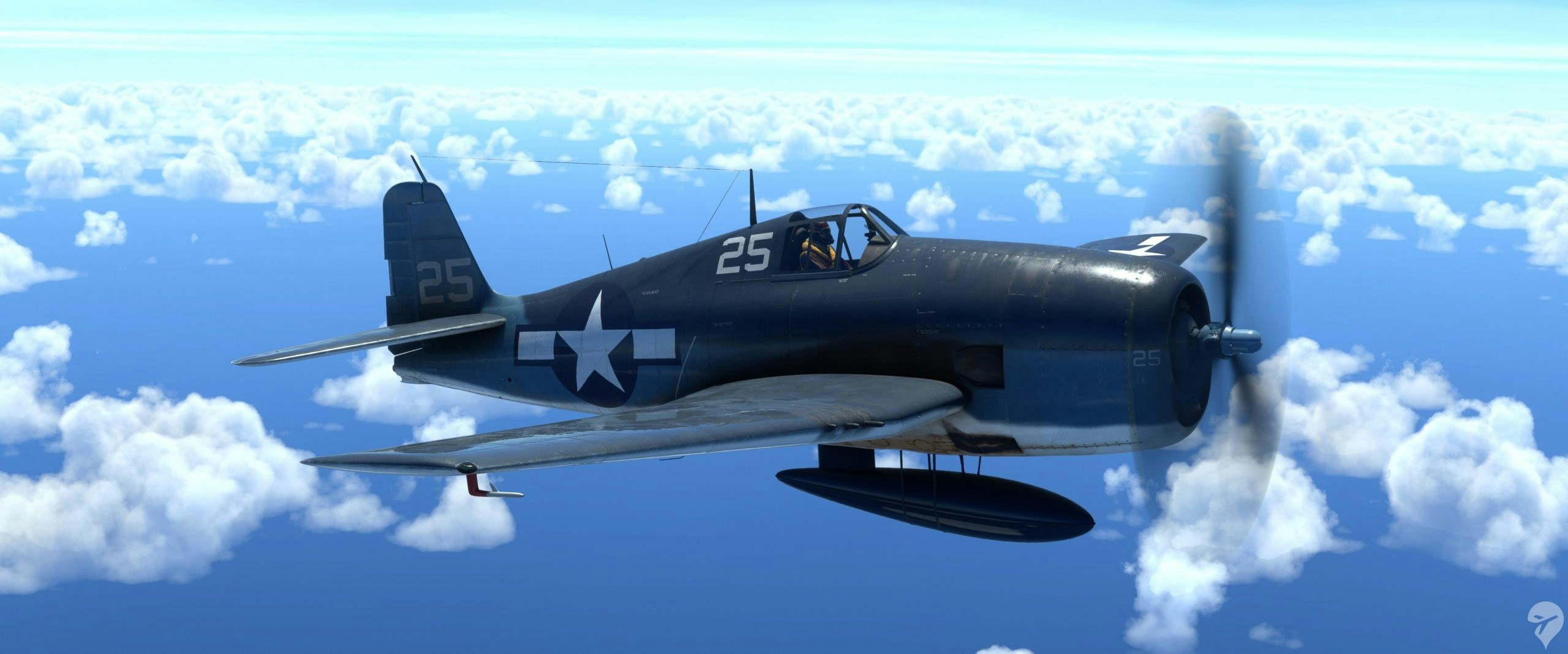
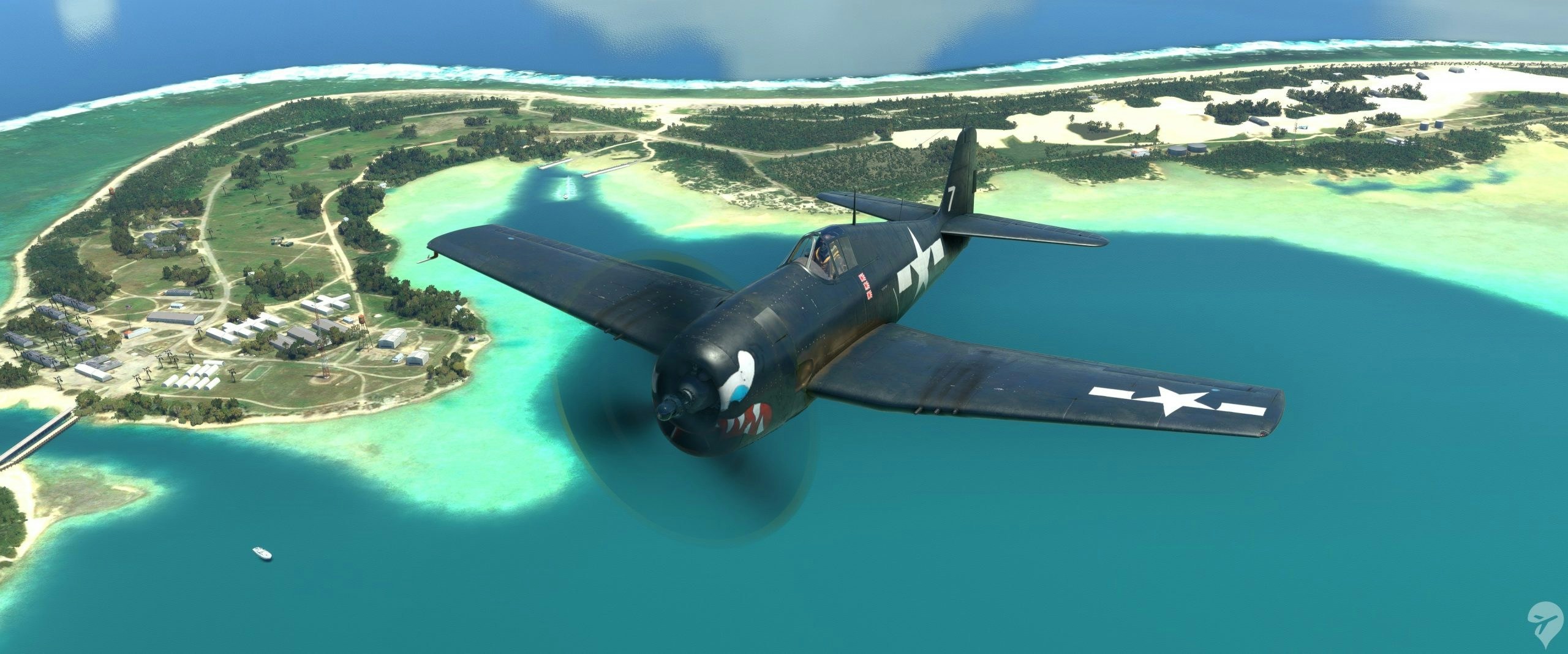
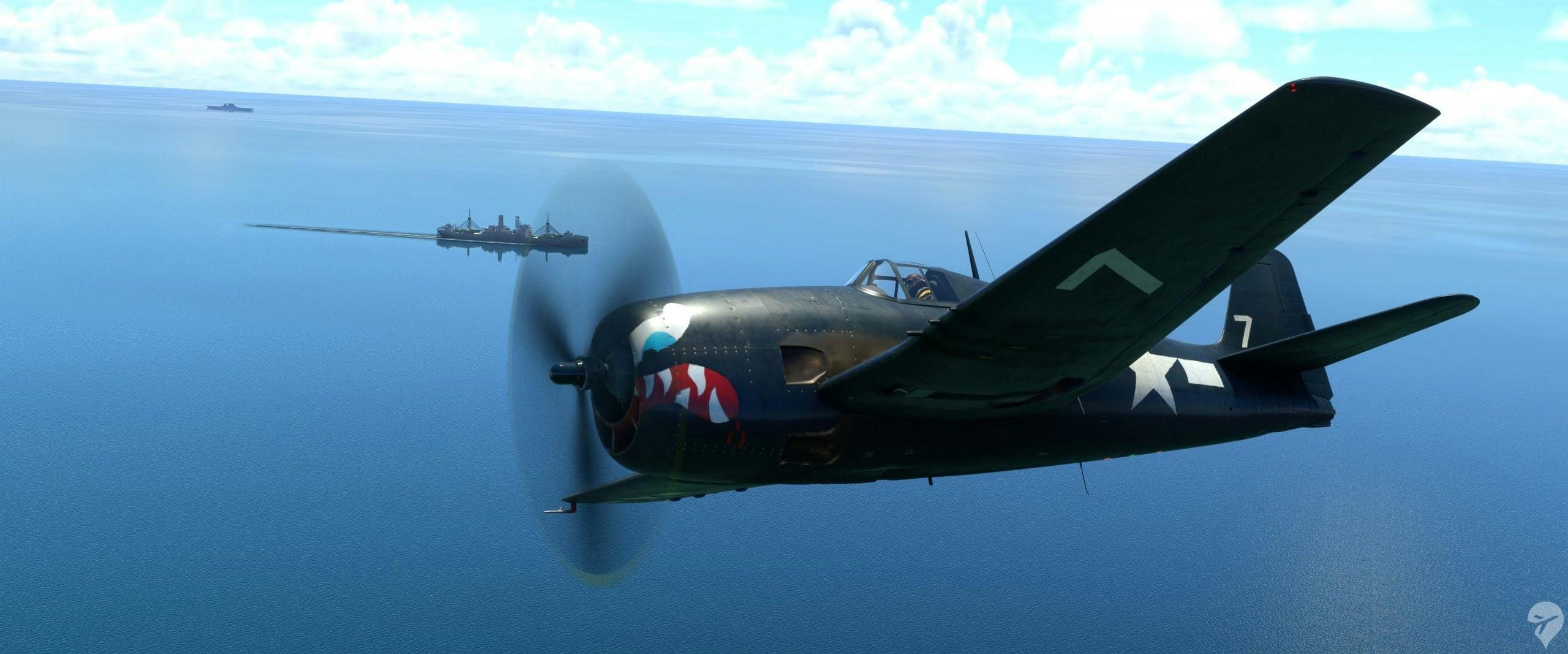
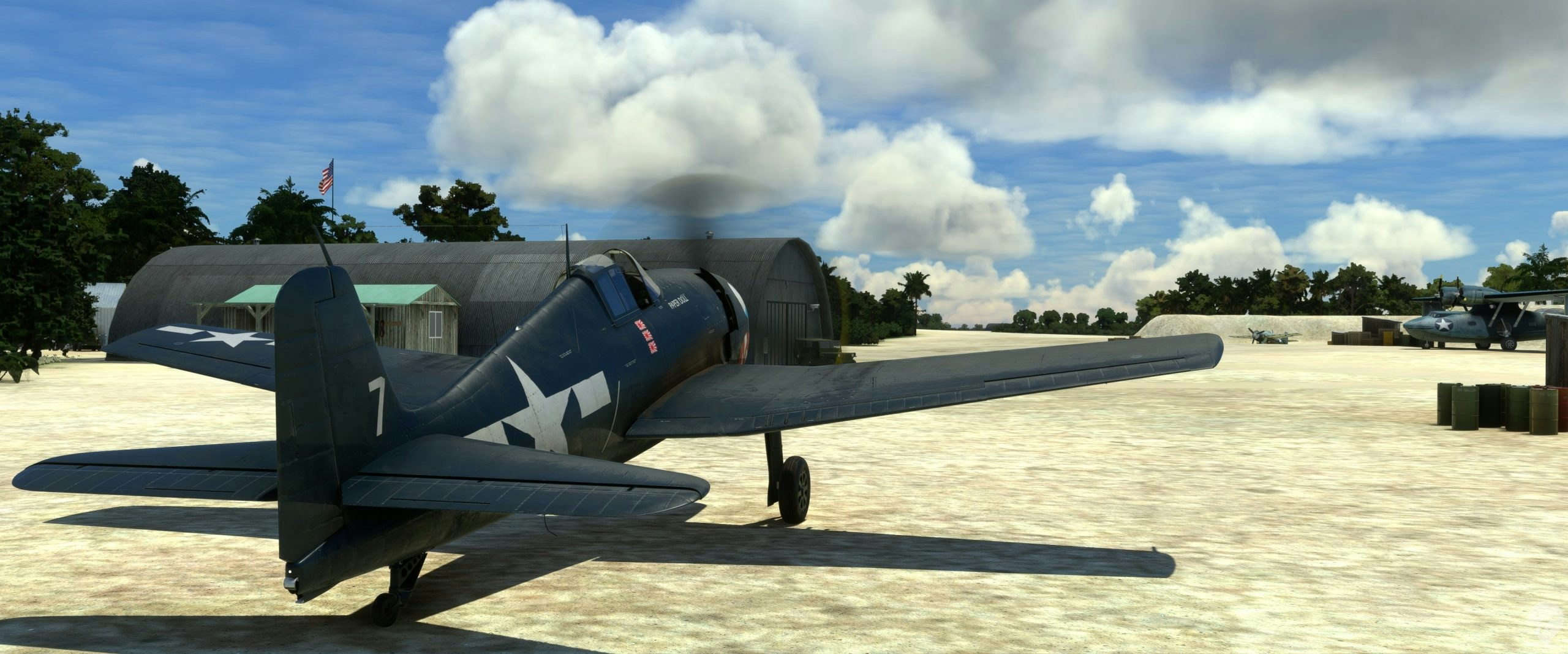
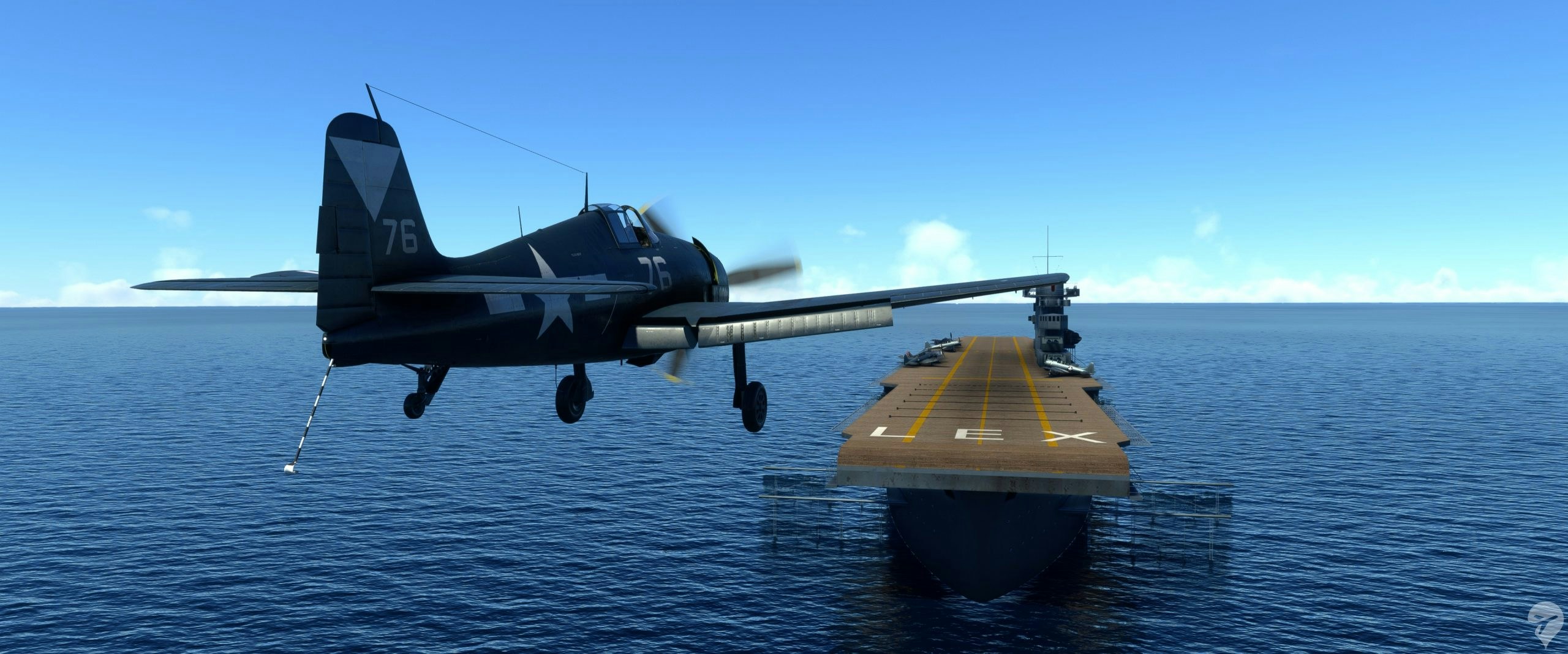
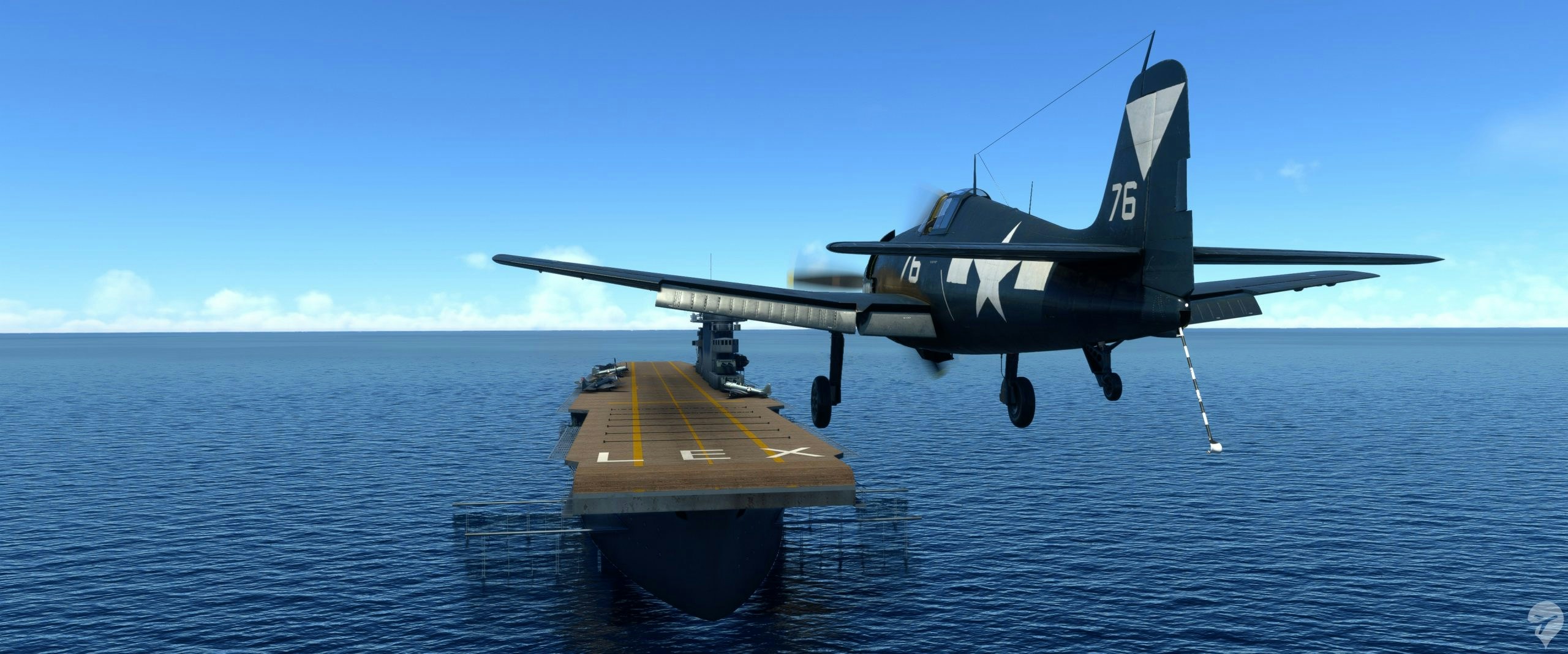

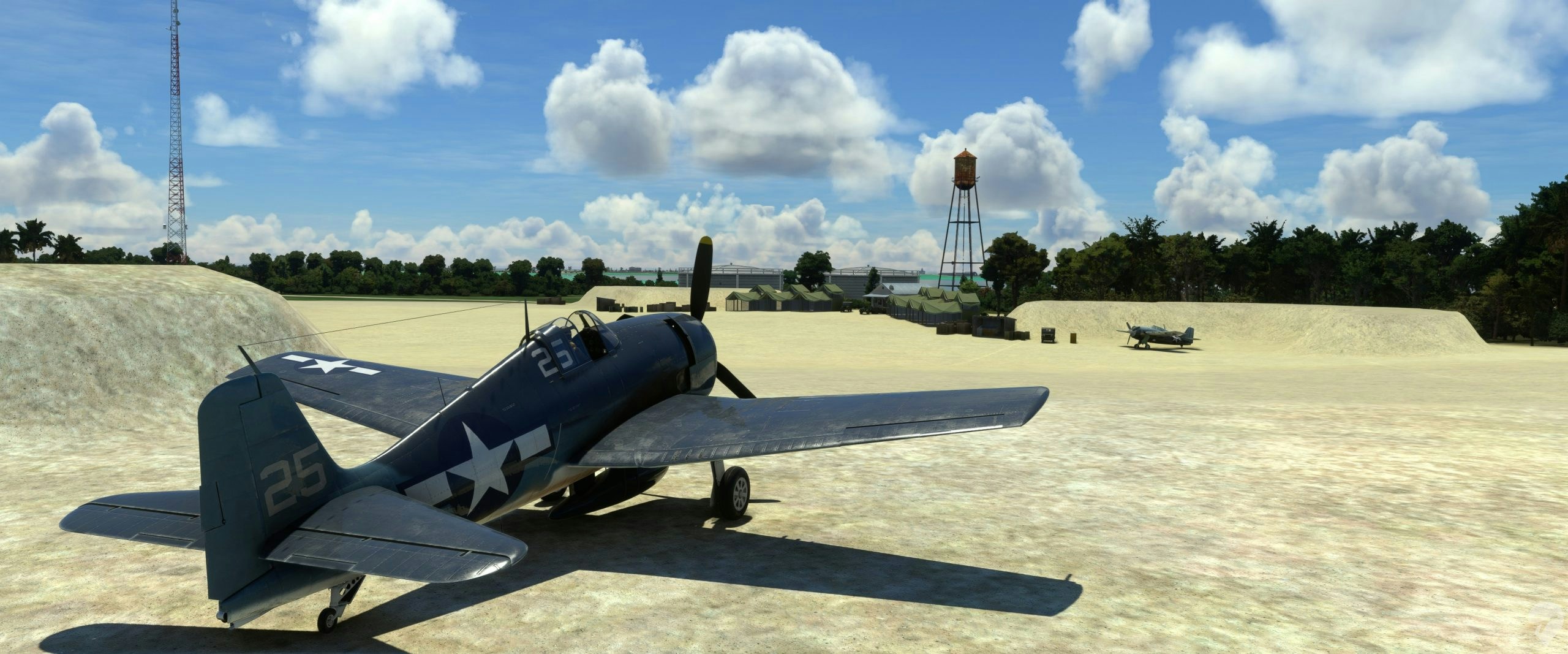
Let’s talk about flying this plane. There is quite a lot to unpack here because the “temperamental” engine requires a lot of management throughout various stages of flight. For taxiing, FlyingIron has developed custom functionality to simulate a taildragger. I’ve seen several developers develop their own tail-dragging mechanism for MSFS, and to date, the one in the Hellcat is the best one, hands down. It feels very realistic and accurate, and it’s the first time I actually feel like I’m taxiing a taildragger. Having said that, I’ve encountered a few small issues with it where the wheel gets stuck in a certain position despite me not giving any input. On take-off, the engine torque is actually quite manageable, with a slight left-leaning tendency that can be countered with a little bit of aileron trim and rudder input. It becomes more challenging when this plane gets airborne. To start with, the engine requires quite a precise balance of manifold pressure and RPM, as well as cooling. The engine temperature is not only impacted by your RPM and MP settings, but also ambient temperature, prop wash, airspeed, and altitude are factors that need to be taken into account. At your disposal are cowl flaps, oil cooler shutters and an intercooler which you’ll need to use to keep this engine cool, even when using the plane at its reference engine values. FlyingIron Simulations’ custom system modelling of this aspect is incredibly intricate, and although it’s a bit of a daunting task at times, it’s also very rewarding when you get it right. However, I do wonder if the temperature modelling is entirely accurate. Under normal circumstances, flying it according to the reference sheet provided in the manual (below max. continuous), the plane still has a tendency to run hot and I find myself needing the oil cooler shutters and cowl flaps more than I had expected. As for the flight characteristics, the F6F Hellcat is not super fast, although by no means slow. The turn and roll rates are a little low which I believe is quite accurate.
The engine of this plane features a two-speed, two-stage supercharger, and in my opinion, this is where FlyingIron Simulations has dropped the ball. As long as you’re flying below 12,000 feet the supercharger does not kick in and will stay in neutral. Above 12,000 feet the supercharger will kick into ‘Low’ and into ‘High’ above 25,000 feet. Where FlyingIron has dropped the ball, in my opinion, is how the supercharger is controlled. The team claims that MSFS has quite limited functionality for the supercharger, and therefore manual supercharger selection is not possible. That means that as soon as you go above 12,000 feet the first stage of the supercharger automatically kicks in, which causes your plane to drastically change behaviour and requires you to change the power settings – unless you were carefully anticipating this altitude transition. It also means that flying at 12,000 or 25,000 feet is absolutely not viable because the supercharger will kick in and out if you have deviations in your altitude. Having no manual control also means you need to carefully anticipate transitioning through these altitudes (both when ascending and descending), because if you do not, you will easily overheat or otherwise damage your engine, rendering your remaining flight time quite short. This is a problem for people that like to perform acrobatics at several altitudes or simulate dogfights. I do appreciate that MSFS might have limited supercharger support, and the team felt they had no better solution. Having said that, we’ve seen the FG-1D Corsair by Blackbird Simulations (previously Milviz) that features the same R-2800 Double Wasp engine with two-speed, two-stage supercharger tackle this problem and that plane does allow for manual supercharger control. Either way, the current implementation of the supercharger is a pretty big limitation on this aircraft at the moment.
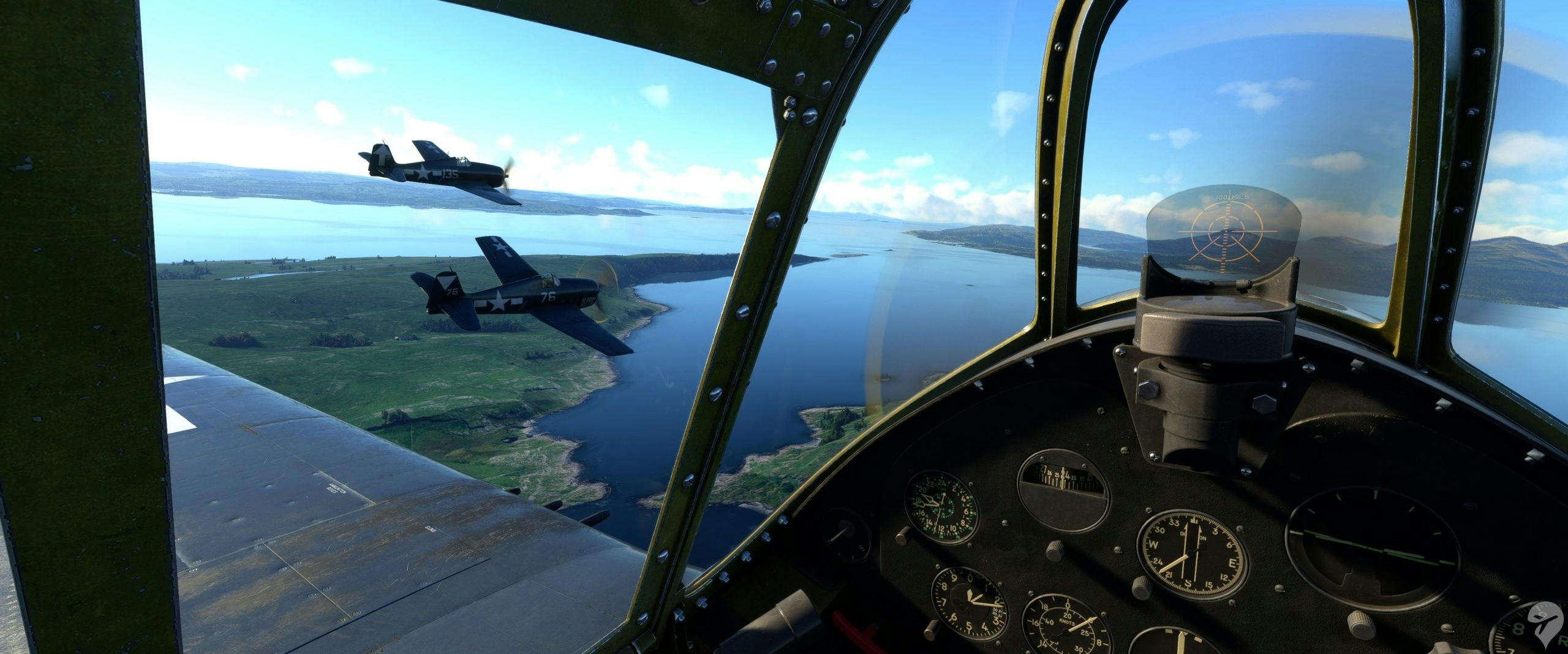

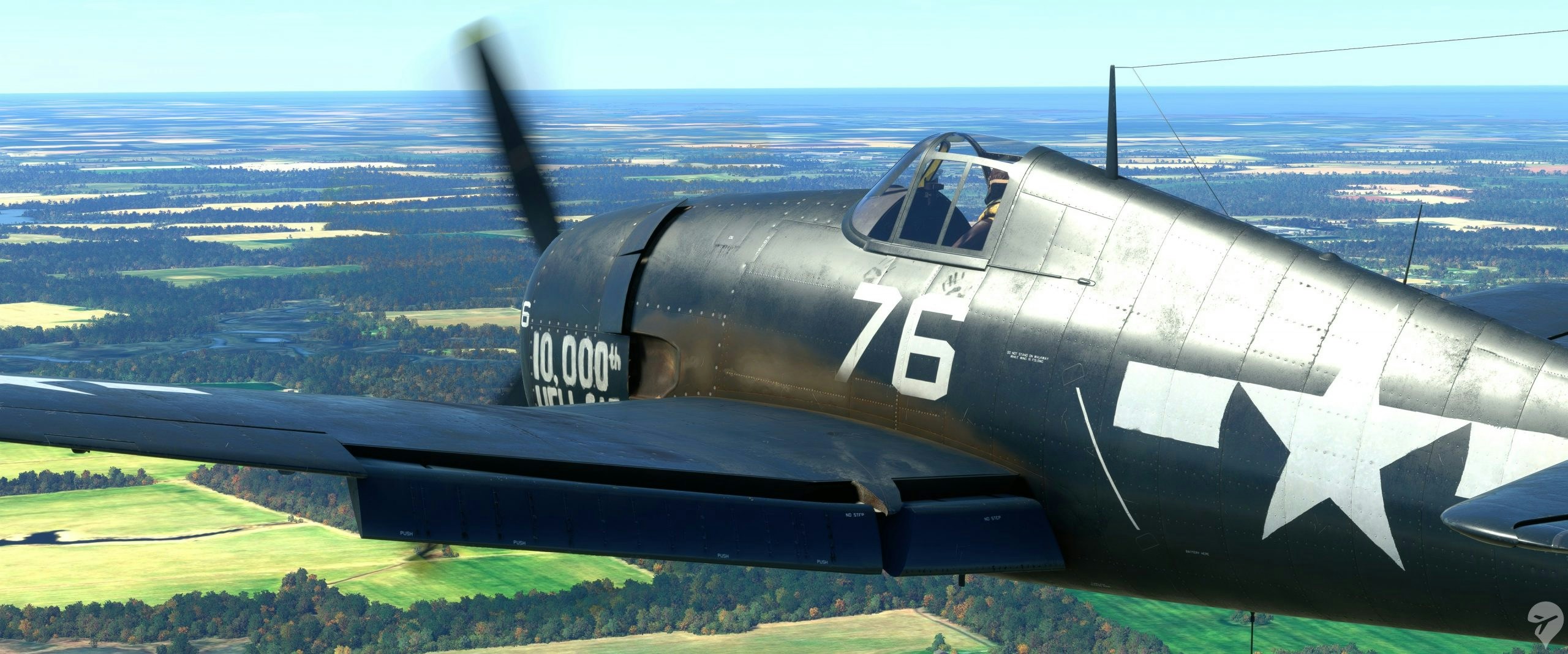

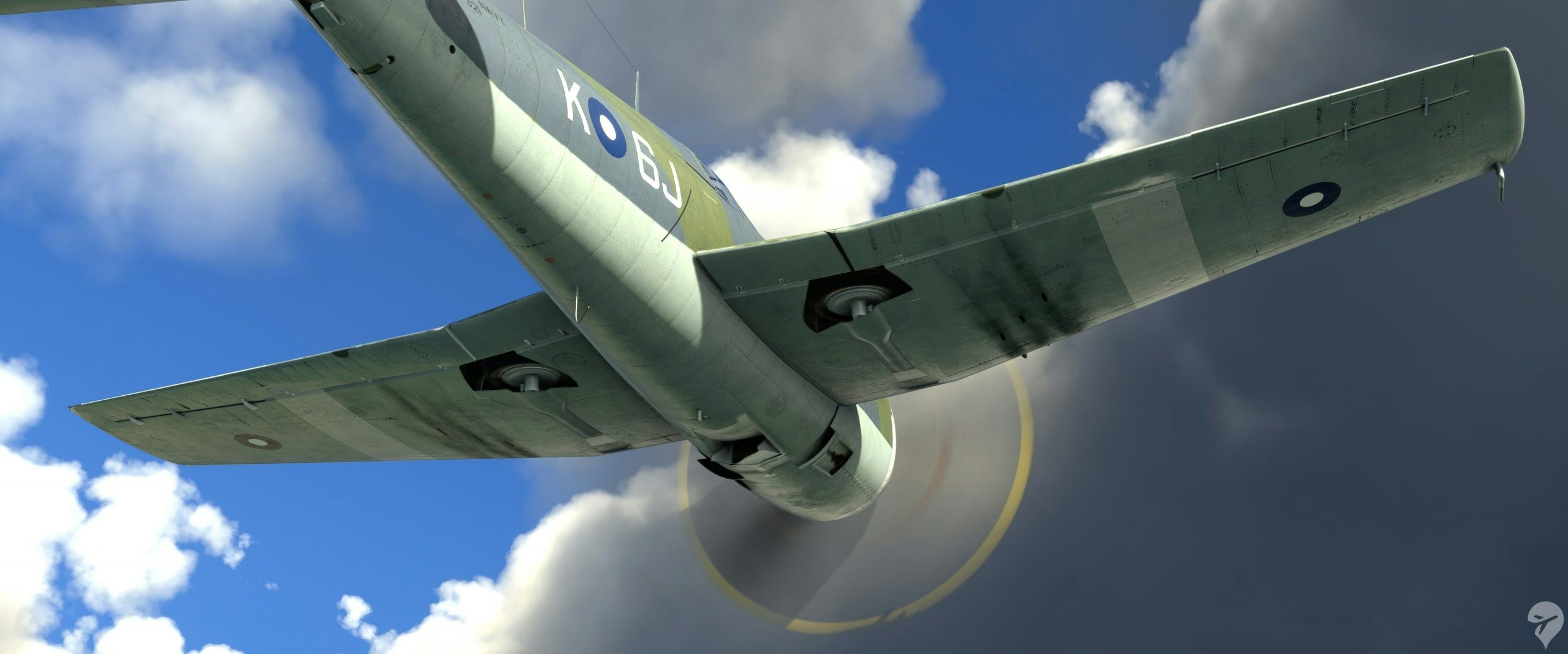

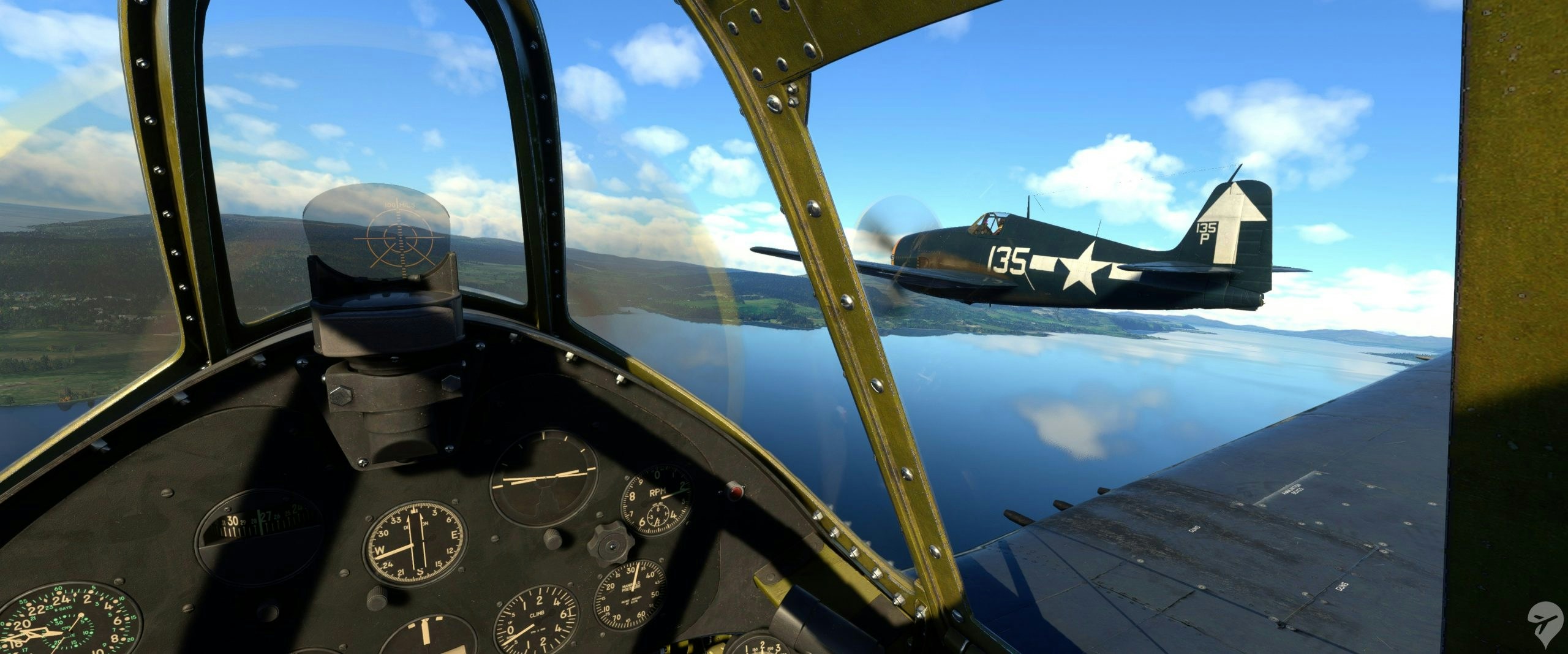
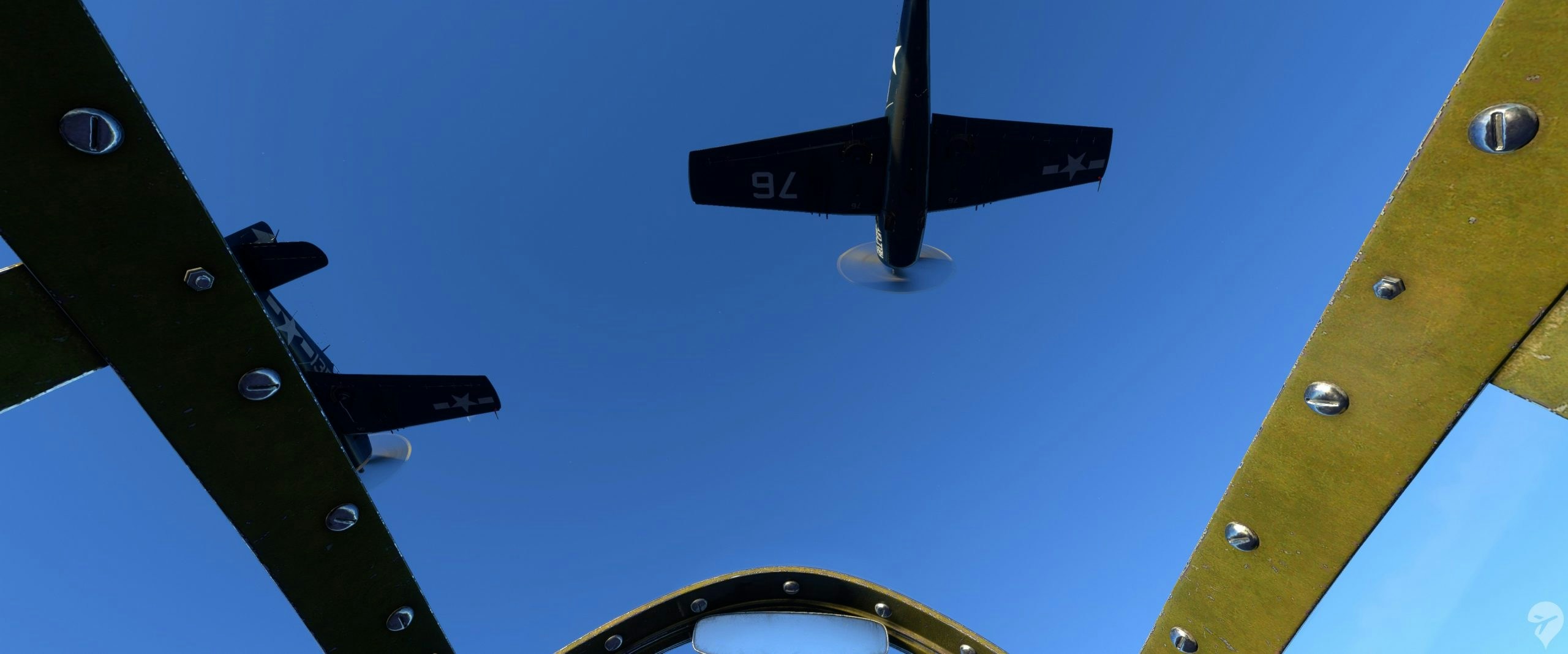
Another thing that needs to be mentioned about this plane is the FlyingIron Simulations tablet. This handy tool has a multitude of functions. You’ll find checklists here to simply get the plane going, a load-out manager for the fuel, and you can see all the actual live data from your aircraft. This might come in handy if you want to double check why your engine is behaving the way it is or if you simply want to understand the plane better. The tablet also features a rudimentary auto-pilot that can hold heading and altitude if you want to make long range sorties. Also included are a few settings, such as disabling the spinning prop (visual), toggling the WWII pilot on or off, or toggling between GPS or gunsight. New in the tablet is the ‘Workshop’. Here you’ll be able to see your plane’s wear and tear based on how you’ve been (ab)using the plane. You’ll see the components of your plane degrade here depending on usage, such as running the engine too hot, or how often you use the brakes. At the moment of writing, no systems on your plane will fail even if they do degrade in the workshop. Hopefully this is something that will still be added at a later date.
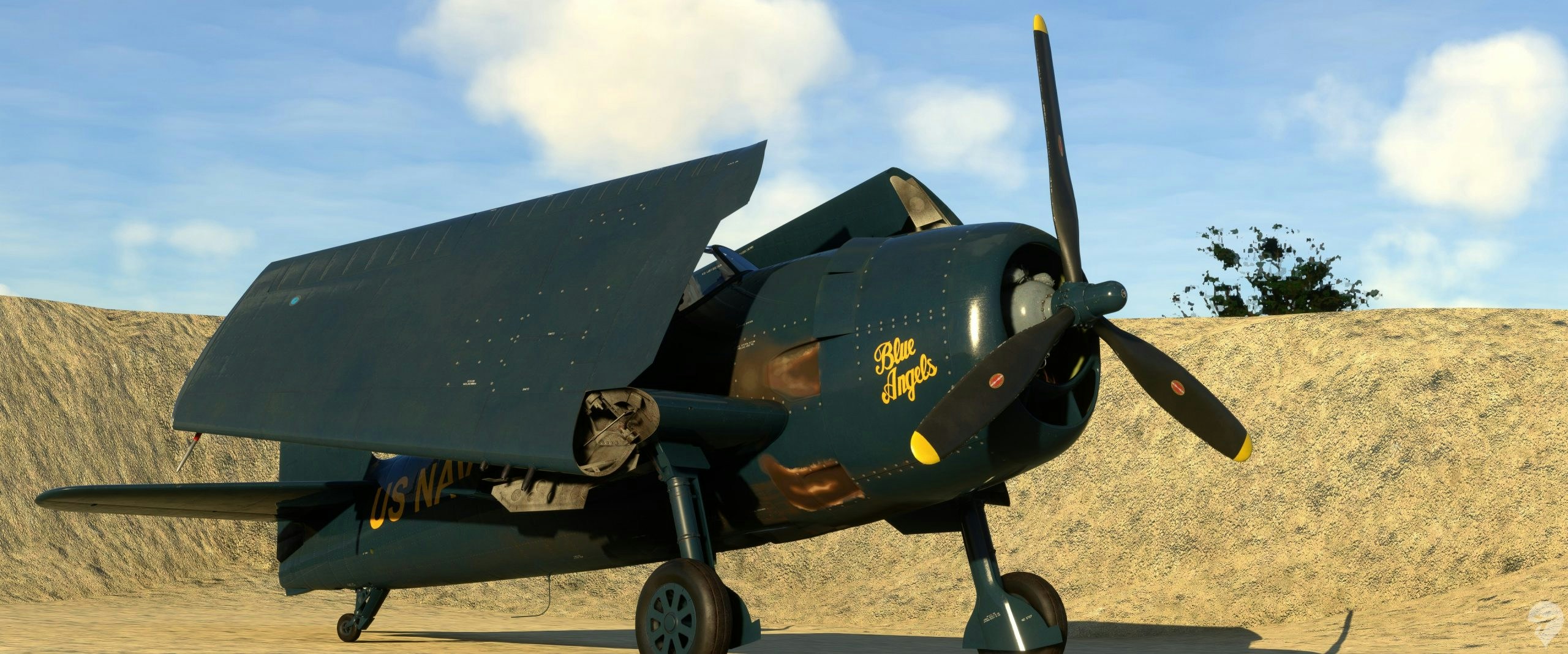

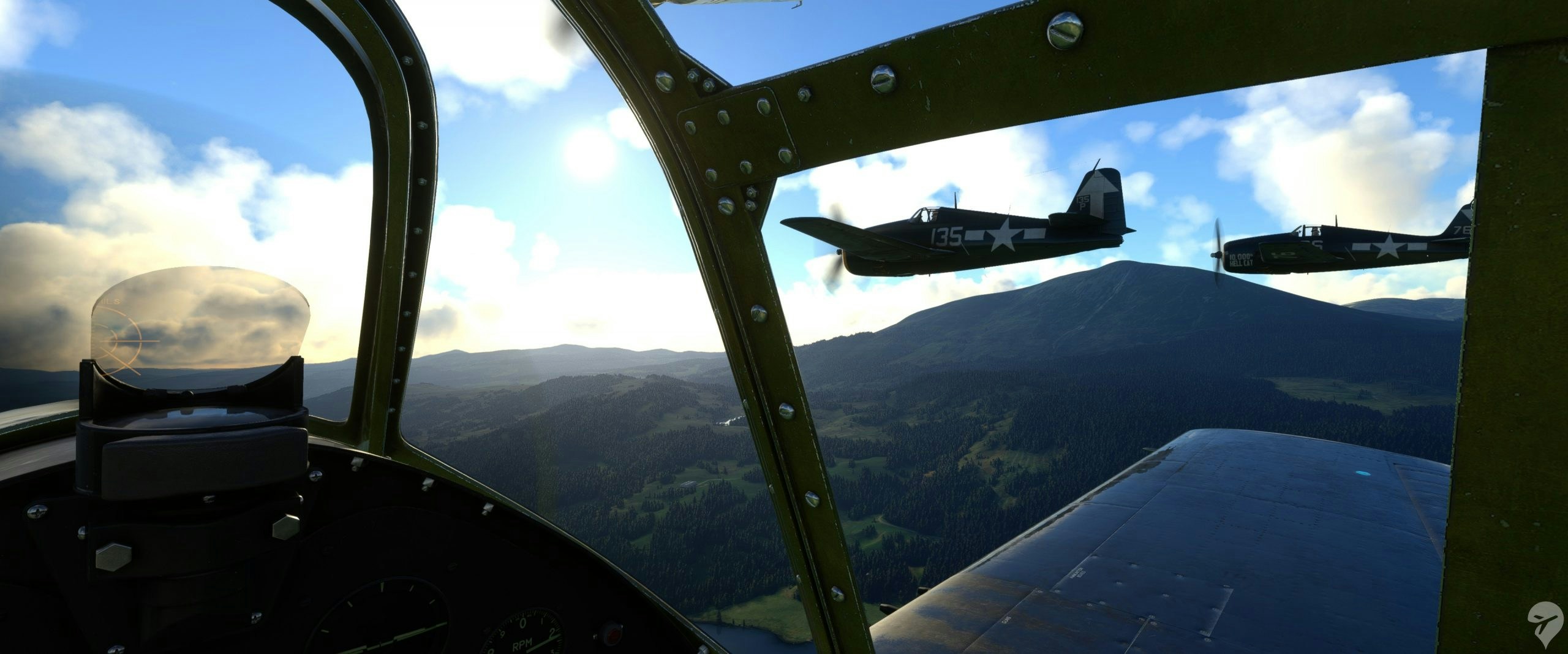
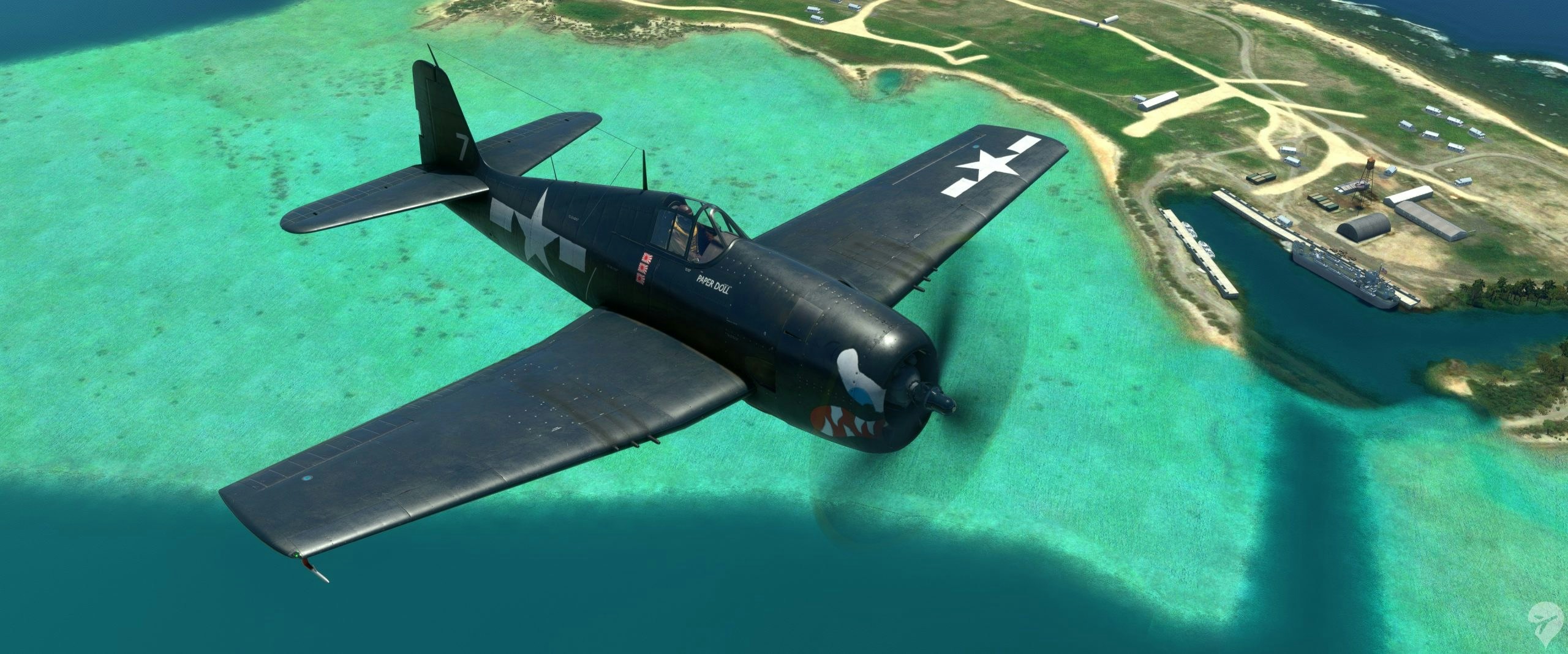
In conclusion, FlyingIron Simulations has once again hit the ball out of the park with their latest aircraft. There’s no accounting for taste, but the Hellcat was probably never going to win a beauty contest. Yet, the rendition by FlyingIron Simulations just might for the way they’ve beautifully represented this historic warbird. After the first few flights, this plane felt daunting and a handful. Now that I’ve flown her exclusively for about a week, in order to create this review, she’s become a lot more joyous to fly. The flight characteristics are very nice, the sound is absolutely amazing, and the modelling and textures are very beautiful to look at. There are a few things I was less happy with, such as the supercharger modelling, a few non-functional controls, some texture details, and the occasional small bugs. However FlyingIron Simulations has previously shown that they are committed to their releases. The Spitfire is still receiving regular and major updates well over a year after its release, and I am fully confident that the Hellcat will receive similar support. Over on their Discord, the devs are very active and engaged with their community, and it’s something I really commend them for. The feature of the collimated gunsight must’ve been one of the most requested features for their planes, and in all honesty, kind of makes you wish the guns were a little more visual with effects à la Blackbird Simulations’ Corsair; but it doesn’t take away of the beauty of this workhorse and the joy of flying this warbird.







